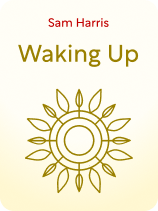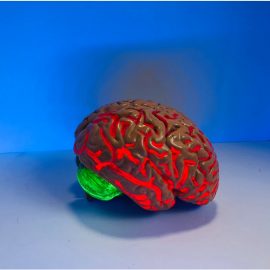

This article is an excerpt from the Shortform book guide to "Waking Up" by Sam Harris. Shortform has the world's best summaries and analyses of books you should be reading.
Like this article? Sign up for a free trial here.
Do you practice mindfulness and meditation? Can it be done outside of the context of religion?
According to Sam Harris, mindfulness and meditation are the way to contentment. In his book Waking Up, he starts from a simple foundation—everybody just wants to be happy. While many people look to religion to find happiness, Harris says that you don’t need to go there.
Read on to understand Harris’s secular take on mindfulness and meditation.
Sam Harris on Mindfulness & Meditation
Unfortunately, on the “hedonic treadmill” of our materialistic culture, peace and contentment are always somewhere in the future while you try to run away from the pain in your past. Spiritual endeavors, such as prayer and contemplation, are an attempt to break yourself out of this cycle, bringing your awareness into the here and now. This is the practice of mindfulness—the deliberate choice to focus your awareness on the present moment and experience it without judgment. Happiness and tranquility can be found only in the present because the present moment is all you can actually experience.
According to Sam Harris, mindfulness (in the form of meditation) teaches three simple truths:
- Your thoughts shape your subjective experience.
- Positive emotions are skills you can train.
- Your “sense of self” is an illusion.
(Shortform note: While many writers, including Harris, conflate the practices of mindfulness and meditation, by some definitions they’re two different things. In Hyperfocus, Chris Bailey argues that mindfulness means being aware of everything going on around and inside you, whereas meditation entails narrowing your attention to one thing. In The Power of Positive Thinking, Norman Vincent Peale describes the act of prayer in a similar way—as a method to focus your spiritual energy on one particular problem or need. In Mindfulness in Plain English, Bhante Gunaratana resolves the mindfulness/meditation dichotomy by explaining that mindfulness should be your ultimate aim, while meditation is the practice for achieving that goal.)
Meditation and the Mind
Since current scientific methodology is insufficient to fully explore the nature of the mind, Harris turns to meditative introspection to investigate the properties of consciousness, identity, and selfhood, as well as what it means to transcend them. Harris describes the fundamentally subjective nature of consciousness, how it can be explored on a personal level, and why consciousness and individual selfhood are two separate aspects of the mind, with the latter being more illusory than you think.
In this context, consciousness is your subjective awareness of your existence and that of the world around you. The limiting factor in examining consciousness is that nothing but consciousness can observe it, and only from a first-person point of view. You can examine your own conscious mind, but you can’t directly observe the minds of others, and no one else can directly observe yours. This has led some thinkers to suggest that consciousness itself is an illusion, but Harris says that argument is silly. If consciousness is an illusion, then the experience of that illusion is proof that consciousness is real.
(Shortform note: Several other writers define consciousness differently than Harris, though still in terms of subjective experience. In Homo Deus, Yuval Noah Harari lists desire as one of consciousness’ defining characteristics. In Flow, Mihaly Csikszentmihalyi discusses consciousness purely in terms of attention and intention. In The Untethered Soul, Michael A. Singer takes a stance diametrically opposed to Harris’s, insisting that the self is the only real identity, and consciousness is merely the window through which the self can experience life.)
It’s through spirituality, which Harris defines as deep contemplation of your conscious mind, that you can truly learn about yourself. While psychology has demonstrated the underlying power of the unconscious mind, it’s in your conscious awareness that you subjectively experience life, the universe, and everything in it. Consciousness is where you feel pain and pleasure, as well as where you make moral judgments. For example, consider the widely held conviction that it’s wrong to inflict pain on another being. That conviction stems from a person’s subjective experience of pain and a conscious understanding that other people and creatures are capable of the same subjective experience.
(Shortform note: Not everyone agrees with Harris that so-called “moral behavior” is a product of the conscious mind. In The Selfish Gene, Richard Dawkins proposes that behaviors that might be viewed as altruistic are in fact biological adaptations that promote the health and survival of a group so that their shared genetic makeup can propagate into the future. If this view is correct, then the moral judgments that Harris refers to might be no more than our conscious rationalization of behaviors whose true motives are unconscious drives.)
Too often, such moral judgments are seen as the purview of religion, yet even religious practices can shed light on the nature of consciousness. For instance, consider monastic traditions that seek inner peace through contemplation and self-isolation. Harris suggests that, while these monks are attempting to commune with the divine, they’re also conducting a philosophical experiment to determine if psychological health can exist outside the struggle for self-gratification that defines the normal, everyday world. Over the centuries, these experiments have yielded many positive results, including transcendental states of mind, especially when meditative practitioners have learned to silence their own inner monologues.
(Shortform note: Though Harris presents an image of monks as silent, meditating hermits, the reality behind the stereotype is that monasteries are active communities in which every member must work and contribute. While life in a monastery or convent is certainly less driven by materialism than in the world at large, living in close quarters with many other people requires the same level of interpersonal finesse as working every day in a corporate office. Despite that, the monastic example demonstrates that contentment can be found by slowing down, being mindful of your feelings, and letting go of old patterns of behavior.)
Separating Consciousness From Selfhood
The crux of Harris’s argument in favor of a “secular spirituality” is that a meditative practice can help you find tranquility by experiencing moments of pure, unfiltered consciousness. This happens when you experience consciousness without thought, when you let your inner voice—as well as the constant churn of emotions that your thoughts inevitably trigger—slide away. Harris says that if you can experience awareness unburdened by your constant internal chatter, you’ll realize that your consciousness is independent of any feelings of personal identity and selfhood, and that your sense of identity is merely an illusion. This is a counterintuitive concept, so some definitions are in order.
When Harris says the “self” is an illusion, what exactly does he mean? The selfhood he’s referring to is the feeling that you’re an incorporeal being sitting inside your head, looking out through your eyes, and steering your body like a vehicle. Harris asserts that this particular feeling is a product of what he calls “psychological continuity,” the constant creation and narration of memories about your physical and cognitive experiences from one moment to the next. This moment-to-moment continuity creates the illusion that the “you” inside your head is the same “you” you were yesterday or will be tomorrow. But is that really the case? Are “you” the same person “you” were five years ago, or when “you” were a child?
However, when meditation interrupts your mental chatter, you experience awareness unclouded by the internal narrative that normally defines your sense of identity. You realize that from a subjective point of view, all that can really be said to exist is your present awareness and the thoughts it contains. Harris isn’t arguing that you don’t exist or that you haven’t experienced the things you remember. What he’s saying is that your sense of selfhood is a construct of your memories and thoughts, and that it covers up a deeper reality—that all you really have is your conscious awareness, which isn’t defined by the thoughts, feelings, and memories that routinely impinge upon it.
The Path of Mindfulness
To quote Hamlet, “There is nothing either good or bad, but thinking makes it so.” Taking control of the chatter in your mind requires accepting that your response to any situation—whether it’s suffering, elation, or indifference—is entirely the product of your thoughts. Mindfulness lets you choose your responses consciously instead of giving in to habitual reactions, such as anger or resentment. Harris cautions that he’s not recommending you detach from reality; he’s just stating that you don’t have to let the outside world dictate your emotional responses.
(Shortform note: This is another point on which Harris’s writing overlaps with the Stoics. As described by Derren Brown in Happy, the tenet behind the Stoic way of life is that of taking responsibility for your thoughts and feelings. For Stoics, this is practical advice for achieving contentment rather than a path to transcendentalism. Nevertheless, just like Harris, the Stoics don’t advocate detachment from the world, merely detachment from thoughtless reactions. In The Daily Stoic, Ryan Holiday and Stephen Hanselman affirm the Stoics’ engagement with worldly issues—they simply practice detachment from the outcome of their efforts.)
Harris also warns that a fully contemplative approach to life requires a certain intellectual maturity, though mindfulness practices have benefits for people of all ages, such as teaching emotional self-awareness. There are certain psychological and physical conditions that meditation practices could actually make worse. If you suffer from one of those, Harris recommends consulting a physician before launching yourself on a meditative journey.
(Shortform note: Harris doesn’t elaborate on the specific reasons why someone shouldn’t meditate, but like any other mind-altering practice, it comes with a certain degree of risk. For instance, people suffering from severe depression may find that meditation exacerbates their symptoms, and some trauma survivors have reported having flashbacks while attempting to focus during meditation practice. If inward-looking meditation might be distressing or dangerous, an alternative is to find mindfulness practices that focus your attention outward, such as hiking, gardening, or artistic creation.)
If you decide to pursue meditation, Harris says it’s important to find a good teacher, someone who can model the calm and sense of presence you’re trying to achieve on your path to enlightenment. However, be wary. The teacher-student relationship is ripe for exploitation, and the role of spiritual guru is especially attractive to frauds. Even teachers who offer good meditative guidance will sometimes make spurious claims about science or medicine as it relates to their field. As in all things, it’s good to maintain a certain level of skepticism, especially if you feel you’re being conned or abused by someone who claims to be a spiritual master.
(Shortform note: Telling the difference between an authentic spiritual teacher and a fraud can be tricky. In The Confidence Game, psychologist Maria Konnikova explains that frauds don’t just lie about themselves, but they also exploit your confidence in your personal narrative. A skilled con artist identifies your unspoken desires, mirrors your values and personal experience to gain your trust, then uses that leverage as a means to convince you to do what the con artist wants. According to Konnikova, those who’ve fallen victim to religious frauds or cults often have strong feelings of denial that they’ve been conned at all.)
| Choosing a Meditation Practice Finding the most effective meditation routine for your personal journey can be daunting, given the vast amount of writing on the subject. Shortform’s Master Guide to Choosing a Meditation Practice can help with a general overview of the field, covering the four major variations: Buddhist meditation focuses mainly on mindfulness, managing strong emotions, and practicing compassion. Its aim is finding happiness through self-improvement rather than seeking a connection with the divine. Hindu meditation, also known as yoga, is directed at achieving a union with the divine, though with its focus on posture, breath, and concentration, it’s been known to offer benefits to physical health. Christian meditation, equated with prayer, is envisioned as a way to communicate with God, and it can result in a greater sense of well-being and purpose in life. Western meditation, while harder to define than older traditions, generally focuses on self-improvement through achieving goals and manifesting the life that you want. |
The Meditation Journey
Of course, meditation is a skill that must be practiced. When you first learn to meditate, you may feel an initial thrill of success. However, as you practice, you may feel more and more distracted during meditation. Harris writes that this is a natural step along the way, and though it feels like you may be getting worse at meditating, it actually means you’re getting better. If you start to feel distracted while meditating, it means you’re getting better at noticing your thoughts—in other words, you’re on the right track. True enlightenment may still be very far away, but you’ll find that the process of getting there makes your mind incrementally healthier.
Eventually, during meditation, you may notice your consciousness as it exists between one thought and the next. When this happens, you can finally understand that you are not your thoughts. Instead, you are the conscious awareness that your transitory thoughts pass through. It’s as if your awareness is a movie screen, and your thoughts are the images projected on it. No matter what those images are, they can’t harm the screen itself.
This is spiritual enlightenment at its core—that consciousness without thought is your true, underlying experience. Harris doubts that anyone can live in this state of awareness all the time, but he does believe that through practice you can glimpse it. Doing so can free you from the suffering triggered by the thoughts projected on the blank screen of your mind. How can you suffer when the “self” that is suffering is just an illusion, a “movie special effect” of the brain?

———End of Preview———
Like what you just read? Read the rest of the world's best book summary and analysis of Sam Harris's "Waking Up" at Shortform.
Here's what you'll find in our full Waking Up summary:
- Why those who reject religion are missing out on something crucial
- A reason-based approach to spirituality that’s rooted in science and meditation
- What science and theology have to say about the soul and the mind






